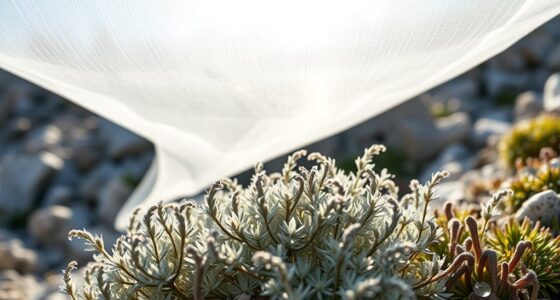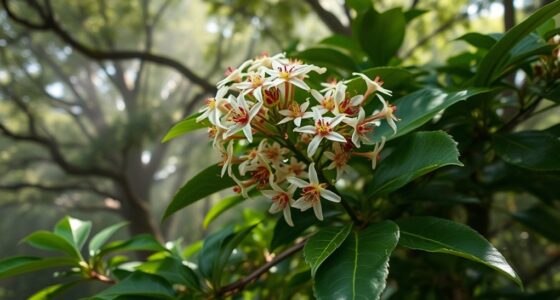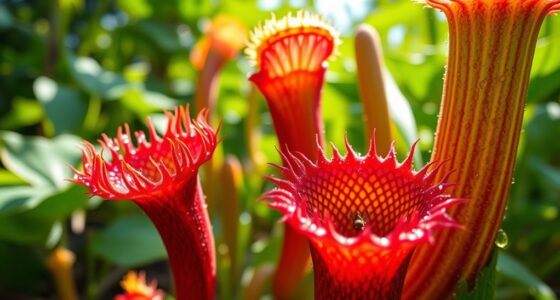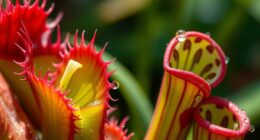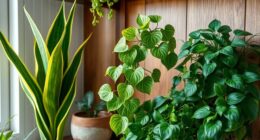Amborella, often called the “first flower,” is a vital living relic that helps you understand plant evolution. As the most primitive known angiosperm, it retains ancient traits and offers insights into how flowering plants originated and diversified. Its genetic makeup reveals early divergences from other plant lineages, rewriting traditional evolutionary trees. If you look closer, you’ll learn how Amborella reshapes our view of plant history and evolution’s earliest steps.
Key Takeaways
- Amborella is the most primitive living angiosperm, offering crucial insights into early flowering plant evolution.
- Its genetic makeup reveals ancient relationships with gymnosperms, shedding light on angiosperm origins.
- As an early diverging lineage, Amborella helps redefine plant family trees and evolutionary timelines.
- Morphological features of Amborella reflect primitive traits, illustrating the transition from ancestral to modern flowers.
- Protecting Amborella’s habitat is vital for studying plant evolution and understanding Earth’s botanical history.

Amborella, often called the “first flower,” holds a special place in plant evolutionary history because it is considered the most primitive living angiosperm. This small shrub, native to the remote rainforests of New Caledonia, serves as a living window into the earliest stages of flowering plant evolution. Unlike many other plants, Amborella has preserved traits that date back hundreds of millions of years, making it a vital piece in understanding how flowering plants, or angiosperms, developed and diversified. Its simple, undivided leaves, unbranched flowers, and unique reproductive features reflect a primitive design, giving you a glimpse into the ancestral forms that once dominated Earth’s landscape.
Amborella, the first flower, reveals early angiosperm traits and evolutionary origins.
By studying Amborella, you can see how early angiosperms might have looked and functioned. Its flowers are small and lack the complex structures seen in more advanced plants. Instead, they feature a simple arrangement of reproductive organs, such as a small number of carpels and stamens. These traits suggest that Amborella’s ancestors had a straightforward reproductive system, which over time evolved into the more intricate arrangements found in modern flowering plants. This simplicity provides insight into the evolutionary steps that led to the diverse and complex world of angiosperms today.
One of the reasons Amborella rewrites plant family trees is its genetic makeup. Its DNA reveals a mixture of ancient and unique features that aren’t seen in other flowering plants. You’ll find that Amborella’s genome contains some genes shared with gymnosperms—like conifers and cycads—indicating that it diverged early from the common ancestor of all angiosperms. This genetic evidence supports the idea that Amborella represents a line that branched off before many of the key innovations seen in other plant groups. As a result, it helps scientists piece together the evolutionary timeline of flowering plants, showing how and when certain traits emerged.
Understanding Amborella’s position in the plant family tree also highlights the importance of preserving its natural habitat. Because it’s so ancient and unique, losing Amborella would mean losing a direct link to Earth’s botanical past. Its existence challenges and refines your understanding of plant evolution, reminding you that the story of flowering plants is complex and still unfolding. Fundamentally, Amborella acts as a living laboratory—an ancient survivor that rewrites what you thought you knew about the origins and early development of flowering plants. Its study not only deepens your knowledge but also underscores the importance of conserving these natural relics for future scientific discovery.
Frequently Asked Questions
How Does Amborella Differ From Other Early Flowering Plants?
You’ll notice that Amborella differs from other early flowering plants because it’s considered the most basal or primitive living angiosperm. It has unique features like simple flowers and lacking vessels in its xylem tissue, unlike many other plants. Its genetic makeup also shows it diverged early in the evolutionary history of flowering plants, making it a key piece in understanding how modern flowers evolved from ancient ancestors.
Can Amborella Be Cultivated Outside Its Native Habitat?
You can cultivate Amborella outside its native habitat, but it’s not easy. Its specialized climate needs, like high humidity and specific temperature ranges, make it a challenge for most gardeners. You might have luck in a controlled environment or greenhouse that mimics its natural conditions. Keep in mind, its delicate nature and slow growth mean patience and careful attention are essential for successful cultivation beyond its original environment.
What Unique Genetic Traits Does Amborella Possess?
You’ll find that Amborella has some unique genetic traits, such as its primitive floral structure and its position as the most basal known flowering plant lineage. It retains ancestral genes lost in other plants, providing insights into early angiosperm evolution. Its mitochondrial genome is also particularly small and simple, unlike many modern plants, which helps scientists understand the genetic evolution of flowering plants and their early diversification.
How Does Amborella Influence Our Understanding of Plant Evolution?
You might not realize it, but Amborella holds the key to revealing plant evolution’s secrets. Its ancient genetic makeup acts like a living fossil, revealing clues about early flowering plants. By studying it, you gain insight into how plants diversified and adapted over millions of years. This tiny shrub challenges assumptions, rewriting the story of plant ancestry and helping you understand how today’s lush forests and gardens came to be.
Are There Any Threats to Amborella’s Natural Populations?
Yes, you should be aware that Amborella faces threats from habitat loss and climate change, which could impact its natural populations. Deforestation and human activities reduce its available habitat, while changing weather patterns may affect its growth and reproduction. Conservation efforts are essential to protect this unique species, as losing Amborella would mean losing vital insights into early flowering plant evolution and disrupting the ecological balance where it naturally occurs.
Conclusion
Just like a pioneer carving its path through untouched forest, Amborella rewrites the story of plant evolution. Its ancient roots and unique features make it a living window into Earth’s earliest gardens. By studying Amborella, you glimpse the first whispers of floral life, connecting the past to the present. This remarkable plant isn’t just a piece of history; it’s a vibrant reminder that nature’s story is always unfolding, waiting for you to discover its next chapter.



